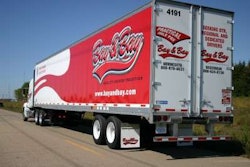In January, Paul Pimentel and Mike Reuter turned in a solid annual report for Morning Star Co. In 2008, the company saved hundreds of thousands of dollars by leveraging technology and financial incentives to improve driver performance.
Pimentel and Reuter are trucking operations coordinators for Morning Star, a leading tomato ingredients processor based in California. Reuter manages a private fleet of 100 drivers at the company’s northern plant in Williams; Pimentel manages 300 drivers at the southern plant at Los Banos.
In 2007, the company started using the “GYR” (for green, yellow and red) driver performance report in its onboard computing platform from Cadec. Morning Star set up the GYR report to track and score drivers based on five areas of concentration: road speed, sudden decelerations, over RPMs, extended idle time and unknown stops.
For each category, the Cadec system records an incident when drivers exceed the established threshold as follows: speed above 63 mph; deceleration more than 7 mph per second; RPMs exceeding 1,700 for more than a minute; idle time exceeding 5 minutes; and stopping at an unknown location.
Pimentel and Reuter assigned each category a weight factor based on company goals. The GYR report computes a driver’s score as the percent he attained out of the maximum score from having zero incidents in all categories. In the cab, the Cadec Mobius computers give drivers an advance warning before any one of the five types of incidents occurs, Pimentel says.
Starting in 2007, drivers received daily, weekly and year-to-date summary GYR reports. Pimentel and Reuter showed drivers how their scores compared to other drivers to create friendly competition. Drivers responded well to being monitored and to the competition, Reuter says. “Improvements were quite encouraging. Drivers embraced it.”
For the start of 2008, Morning Star used the GYR reports to launch a new bonus program. Drivers qualify to receive two percent of their seasonal earnings – about $750 to $1,000 by scoring at 90 percent or better. As an added incentive, drivers receive $100 each week by scoring 100 percent. And at the end of the season, the top 20 performing drivers receive another $500 each. If all of the drivers at a location have no accidents, each driver receives another 0.25 percent bonus.
The final results for 2008 included a decrease in the number of accidents by 75 percent, year over year, and an increase in the ratio of miles per accident by 388 percent. The cost of damaging leased equipment dropped by 25 percent, saving $400,000. The technology and incentives also contributed to an increase in fuel economy from 6.1 to 6.4 mpg, saving hundreds of thousands more. Pimentel expects positive results from the investment in onboard computers and financial incentives to continue this year and beyond.
“The bigger challenge is to improve on what we achieved in 2008,” he says.
When the fleet’s operating season begins in July, the private fleet will lease 230 trucks to transport 1,500 loads every 24 hours, seven days a week, and cover nearly 17 million miles over a 95-day period. When drivers-all of whom are seasonal operators-return to work this year, Pimentel and Reuter are already considering a new incentive: the final 2008 driver rankings of returning drivers will determine who gets the first choice in shifts.
“Bankers hours are highly coveted,” Reuter says.











